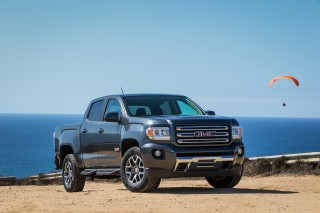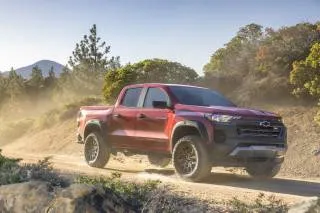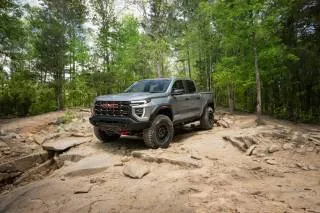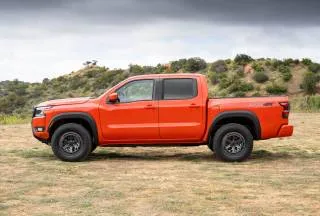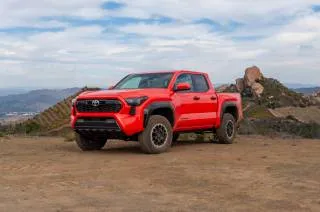Likes
- A wise alternative to a full-size truck
- Strong, efficient, easy-driving diesel
- Versatile in most every version
- Pickup-bed features are thoughtful
- Good interior design and room
Dislikes
- 4-cylinder's a must with the manual
- The Canyon's better-looking
- Cramped, tight rear seats
- Can overlap Silverado in price
Buying tip
features & specs
The 2016 Chevy Colorado is the answer for drivers who don't quite need a full-size truck.
With last year's Colorado, Chevy joined the Toyota and Nissan trucks in the mid-size class. Now it towers over them, not in terms of size, but in terms of modern design. Brand-new along with its GMC Canyon twin, the Colorado simply outclasses the Tacoma and Frontier on a variety of fronts, whether it's packaging and interior space, clever new connectivity and bed features, V-6 gas mileage, or simple things like driving position.
Mid-size trucks effectively replaced compact trucks about 15 years ago, when the Dakota, the Tacoma, and the Frontier all were nudged up in size and mission. Compact trucks like the Chevy Colorado were left behind—until now.
At the same time, it's a real rival for full-size truck buyers in its top versions, punching far above its class with full-size towing and hauling capacity, not to mention horsepower.
The Chevrolet Colorado takes its pared-down truck shape and somewhat more manageable size and offers three powertrains choices.
The standard inline-4 puts it in a huge group of vehicles we'd consider for commuter duty, a hatchback alternative with a lot more usefulness strapped to its back. The base 200-horsepower 2.5-liter inline-4 is a member of the engine family that also powers GM's big sedans and luxury cars, everything from the Impala to the Cadillac CTS. The quietly unobtrusive mill delivers moderate acceleration by way of six-speed manual or six-speed automatic transmissions. If you need the light-duty utility of a truck without the big towing and payload ratings, the 2.5-liter engine is a solid choice.
Those looking to tow up to 7,000 pounds can opt for the available 3.6-liter V-6 that produces 305 horsepower and improved, mid-range acceleration. The V-6, which also does duty in the Cadillac ATS and CTS, is a bit grumpy under full trot but not nearly as rough as some other V-6 options in the mid-size segment.
But if it's torque you're after, look no further than the Colorado's new 2.8-liter turbodiesel. The 181-horsepower inline-4 delivers 369 lb-ft of torque, good for 30 mpg highway and a tow rating of up to 7,700 pounds.
The Colorado's ride and handling characteristics are defined by its fully boxed frame, front coil suspension and coil-over front shocks, and a live rear axle with leaf springs. Make no mistake, while the Colorado way still utilize leaf springs in the rear, its provides a more pleasant, refined drive versus the Frontier and Tacoma, additionally aided by a well-weighted electric power steering system. You can get your Colorado with four-wheel drive while four-wheel disc brakes and long-life rotors come as standard equipment.
Between its three body styles and trio of trims, the Chevy Colorado caters to some distinctive bands of truck drivers. Those who haul passengers often will want the four-door crew cab, with a either a 5- or a 6-foot pickup bed. Solo drivers with more functional needs can make do with the extended-cab Colorado and its standard 6-foot bed. Regardless of cab, front passengers in the Colorado will find copious amounts of space, surrounded by high-quality materials. Drivers are treated to a driving position that's more natural than that found in the Tacoma and Frontier. Rear seats are big enough for two child safety seats or act as tight accommodations if you plan on piling full-sized adults in the back thanks to a lack of legroom. The bolt-upright seatbacks don't help, either.
The Colorado's 6-foot bed may be a tad shy on length compared to its full-size brethren, but an available bed extender means you can secure loads up to 8-feet long if needed with the help of 17 available tie-down locations. That cargo won't make a dent in your bed, either, as the Colorado is offered with drop-in or spray-in bedliners and cargo dividers to ensure everything stays in place. And like nearly all trucks, the Colorado is also available with cargo nets, tonneau covers, and the necessary trailer hitches and harnesses to haul around whatever you so choose. But the Colorado's most unique cargo feature is its GearOn system, which consists of optional racks and carriers for hauling specialized cargo, such as mountain bikes and other recreational equipment.
Chevrolet offers its Colorado in a spectrum of three trims: WT, or work truck, provides the basis of all Colorados; there's the mid-trim LT; and the top-range Z71 off-road trim, which gets unique headlamps, a dark-metal-look grille, and 17-inch alloy wheels. Regardless of trim, six airbags, rearview camera, hill start assist, stability control, and trailer-sway control are standard equipment, while lane-departure and forward-collision alert systems are optional extras.
Keeping you connected are a touchscreen audio system and USB input as standard for cranking your tunes from your phone or music device. Optionally, Colorado buyers can opt for a larger 8-inch touchscreen, additional USB ports, and Bluetooth. Navigation is also an option, while data hounds can add GM OnStar's 4G LTE data connectivity package. New for 2016, the Colorado's MyLink interface now incorporates Apple CarPlay, which uses the truck's touchscreen as a mirror display for some iPhone functions like messaging, mapping, and streaming audio.
Fuel economy ratings for the Colorado range from 20 mpg city, 27 highway, 22 combined rating achieved by the rear-drive turbodiesel Colorado. Many buyers may not opt for the oil burner, and the Colorado's mileage returns with an inline-4 aren't as lucrative as one might expect; an automatic, rear-drive Colorado only manages 20/27/22 mpg. The V-6 fares better against the competition and full-size trucks. The bigger engine can return up to 18/26/21 mpg.
2016 Chevrolet Colorado Styling
The Colorado has less of the traditional-truck look—the one that convinces us more of its ready-to-work roots.
The Colorado stretches and pulls the traditional truck shape in some interesting ways. Ultimately, we think its twin, the GMC Canyon, has a shape that resonates more with buyers and reads more "truck," but the Colorado's global styling cues don't get in the way of what's essentially a good-looking vehicle.
The Colorado is no Silverado twin. While that full-size truck (and its SUV cousins, the Tahoe and Suburban) have been transformed with some relentlessly rectilinear lines, the Colorado adopts a rising beltline and smaller, slimmer grille that soften the usual pickup silhouette. Yes, the fenders are a boxy counterpoint—and to some degree, there's no way to make a truck without making it look like a truck—but those few hints of difference reveal the Colorado's global origins, and how it could end up just as popular in San Diego as in San Salvador or Sumatra.
The Colorado's interior does show its corporate kinship with the full-size Silverado. Rugged, upscale materials and a chunky steering wheel with numerous controls are superior far than what you'll find in the Frontier or Tacoma. Its shield-shaped dash provides a home for an LCD display and its associated primary controls, while a wide console that cuts the cabin in half hosts the Colorado's shifter. While still decidedly a truck inside, the Colorado blends its pickup design cues with features from GM's line of sedans, including familiar seat bolstering, door and dash trim, and even a smattering of soft-touch faux aluminum trim.
2016 Chevrolet Colorado Performance
The Colorado is a vast improvement in ride and handling over the Tacoma and Frontier.
A 2.8-liter turbodiesel inline-4 is the new star of the lineup for 2016. Yet, unless you're regularly exercising most of the Colorado's available payload capacity and towing capability, the 4-cylinder gasoline engine option is worth a look. Historically, GM's small trucks have doubled as economy conveyances, and there's every reason to believe this Colorado is being used that way, too.
The 4-cylinder gasoline engine runs out of energy getting up to more than legal highway speeds, but its 200 horsepower and 191 pound-feet of torque make for a fine medium-speed urban duty vehicle that's the province of contractors and commuters alike.
If you're equally into manual transmissions, you're forced into the 4-cylinder anyway—but GM's 6-speed automatic makes the most of the four's moderate output. It helps the inline-4 wring out acceptable acceleration and fine fuel economy, working unobtrusively with the smooth four to deliver up to 22 mpg on the EPA combined cycle. It's not the economy leader in the Chevy lineup—and rival fours from Toyota and Nissan match its combined ratings—but it's a far better match for the kind of driving and infrequent hauling that a lot of truck buyers do, whether they realize it or not.
If hauling is your main agenda, the available V-6 is there for you, especially if you're downsizing from a full-size pickup. With 305 horsepower and 269 lb-ft of torque available, the V-6 Colorado offers up similar payload and towing ratings to full-size trucks from a decade past. This upgrade engine isn't as quiet as the base four-cylinder mill, but tow/haul mode, automatic grade braking, and an overall more powerful punch make the V-6 a worthy option.
The new Duramax diesel makes its peak power of 181 hp at 3,400 rpm and peak torque of 369 pound-feet at 2,000—and trust us, there's plenty of available torque for easy pulling well under that.
The diesel provides the more effortless, low-rpm performance of a V-8. If you're not pulling a heavy load, acceleration feels quite close to effortless, while even up long grades it doesn't require the dramatic downshifts you might see from a gasoline engine. And if you are pulling a heavy load, its torque helps erase the challenge of uphill grades, while the optional exhaust brake (so-called "jake brake") helps modulate downhill speeds with a full load.
The Colorado provides payload ratings of between 1,410 and 1,540 pounds, just short of its GMC Canyon sibling. But its real trick comes thanks to the available diesel and its 7,700-pound towing capability, making the Colorado king of the mid-sizers and squarely placing it in full-size towing territory. For example, the Ram 1500 in base trim powered by the Chrysler's Pentastar V6 has a maximum tow rating of just 4,190 pounds.
Four-wheel drive is an option on the Colorado, but it's a mechanically simpler setup than the AutoTrac system offered on the Canyon and its automatic mode.
The Colorado smooths over bumps deftly, and the steering tracks mostly true, though like any body-on-ladder-frame design, the mid-sizer transmits a fair share of secondary ride motions through to the cabin. If you're returning to mid-size trucks from compact crossovers, you'll notice the difference—but it's not as much of a downgrade as, say, stepping back into a Wrangler.
2016 Chevrolet Colorado Comfort & Quality
There's more space for people in here, and it's more comfortably arranged than in rival mid-size trucks; driving position is particularly good.
Though it's a mid-size truck, the Chevrolet Colorado does a fair impression of a big boy, when it's configured properly. It's also capable of acting like a commuter car, when it's specified more frugally. Either way, there's more passenger space than its primary rivals, and that space is put to better use, too.
Like its twin, the GMC Canyon, the Chevy Colorado is offered as a four-door crew cab or a less-useful extended cab. The latter comes with a 6-foot-long pickup bed, while the full-fledged four-doors have either a 6-foot or a 5-foot bed.
Either way, the Colorado's interior and space efficiency are light-years ahead of the Toyota Tacoma and Nissan Frontier. Slide into the Chevy truck, and the driving positions and general fit and finish of the competition feel almost antique. The Colorado has somewhat skinny front seats, but it's surrounded by good space (especially head room), a well-finished dash, and lots of small storage slots, bins, and trays. The driving position alone would convince us to upgrade: it has a higher hip point and a more natural relationship to the steering wheel—completely without the splayed-out, legs-out stance you have to adopt in the Tacoma, in particular.
On the fit-and-finish front, the Tacoma and Frontier have a lot of catching up to do, too. The Colorado's tall console stores an iPad out of sight, while also housing the shift lever, a USB port (or as many as four), and a pair of big cupholders. The shifter location's a minor concern, as it sits close to the driver's knee, but it's a minor gripe in a cabin so well turned-out, especially for the class.
The back seat on extended cabs—and on crew cabs, to a lesser degree—is still no competition for a well-designed mid-size four-door sedan, but it's at least as able as some Chevy compact cars. The extended cab just doesn't have enough room in most dimensions to be comfortable for an adult, though a child safety seat will fit; you'll have to sneak it in past a rear-hinged door to get it installed, though.
While the crew cab offers improved leg and knee room in its second row, its cushions sit low with bolt-upright seat backs. If you're regularly carrying rear passengers, a full-size truck may be the smarter choice. But for those who only occasionally need the rear seats, the crew cab's extra rear space and under-seat storage are great for keeping your belongings out of the elements.
The Colorado is a perfect bridge between family crossovers and the mega trucks we call full-sizers today, but only if carrying full-sized adults in the rear is secondary to utility.
2016 Chevrolet Colorado Safety
A rearview camera is standard, but crash tests aren't complete or as of yet, very impressive.
It's possible the Chevy Colorado and the related GMC Canyon are the safest trucks in their class, but complete data is lacking—and the data we have so far is good, but not great.
The Colorado has been crash-tested by the NHTSA. It awarded the pickup an overall score of four stars. On individual crash tests, the Colorado ranges from five stars in side impacts to four stars for frontal-impact protection.
Six airbags, including large side airbags for preventing ejection during a rollover, are standard equipment on the Colorado. Over-sized side mirrors and a standard rearview camera give drivers better visibility. And the Colorado's electronic stability control system is additionally joined by standard trailer sway and hill-descent control systems increased safety when towing and off-roading.
The Colorado's optional forward collision and lane-departure warning systems are a first in the mid-size segment, which could aid the Colorado in earning a Top Safety Pick+ award from the IIHS, provided each of its test scores are "Good," by IIHS standards. The independent agency has not yet fully rated the 2016 Colorado.
2016 Chevrolet Colorado Features
The Colorado leapfrogs other mid-size trucks with features like in-car wi-fi, touchscreen audio, and a rearview camera.
Chevrolet sells the Colorado in three flavors: WT, LT and Z71.
The WT is the basic "work truck," but even its features aren't necessarily bare-boned. All Colorados come with vinyl seats, but they also get a rearview camera; a locking tailgate; tilt steering; power windows; air conditioning; and an AM/FM radio with a USB port and a 4.2-inch touchscreen interface; vinyl seats. These fleet-duty trucks can also be configured with cruise control and keyless remote.
Moving up to the Colorado LT and Z71 adds features like remote start; a sliding rear window; heated front seats; an easy-lowering tailgate; and steering-wheel audio controls.
On the connectivity front, Bluetooth is available, as is the Chevy MyLink touchscreen interface with an 8.0-inch screen (on LT and Z71 Colorados) and multiple USB ports for charging and music storage. MyLink now includes Apple CarPlay functionality, which lets the touchscreen do double duty as a mirrored display for some iPhone apps, from phone and messaging utilities to music and mapping software.
Navigation is also an option on the Colorado, as is GM's OnStar service and 4G LTE connectivity, with some service provided for free during a trial period.
On the accessory front, the Colorado's bed comes with the locking tailgate and bed lighting, and stamped-in detents for two-tier loading. The Colorado has 13 configurable and four stationary load tie-downs in the bed; a factory sprayed-in bed liner is available, as are dozens of accessory systems for loading everything from sport bikes to construction materials, depending on the truck's daily duty.
2016 Chevrolet Colorado Fuel Economy
A turbodiesel arrives late this year; in the meantime, the Colorado's fuel economy isn't that much more impressive than rivals.
It's easy to assume that a mid-size pickup truck like the Chevy Colorado will get better fuel economy than a bigger or older truck. That assumption's mostly correct, but in some ways it's much closer than you'd think—or that we expected.
By the official ratings from the EPA, the Colorado's best fuel economy checks in at 22 mpg city, 31 highway, 25 combined. That's for a Colorado equipped with rear-wheel drive, an automatic transmission and a diesel engine. If you're not in the mood for an oil burner, the figures don't fare as well. A rear-drive, automatic Colorado manages 20/27/22 mpg. Opt for a rare manual and those numbers dip to 19/26/22 mpg. Adding four-wheel drive pushes those down to 19/25/21 mpg.
Compare to a V-6 Chevy Silverado at 19 mpg combined—or to a Ram 1500 V-6 automatic at 21 mpg—and the numbers are fairly close.
Even against the 4-cylinder Nissan Frontier and Tacoma, the numbers are closer than we'd imagined. With a manual, the base Frontier earns 21 mpg combined; the Tacoma 4-cylinder manual matches the Colorado at 22 mpg combined.
However, against its V-6 rivals, it's a better story. Among V-6 mid-sizers, the Colorado tops out at 21 mpg combined with rear-wheel drive and 20 mpg with four-wheel drive. The Tacoma and Frontier top out at 19 mpg combined.
Our own experience with a similar GMC Canyon and about 1,000 pounds of payload suggests 22 mpg is easy to achieve on long interstate slogs.
One side note is that the diesel requires diesel exhaust fluid, a urea solution that you can now get either from dealerships or at many truck stops and some gas stations. That's injected into the exhaust stream ahead of a catalyst to clean up some of these engines' smog-forming emissions, but its reservoir needs to be filled around every 10,000 miles—or a bit sooner if you're doing some heavy towing.






































































































